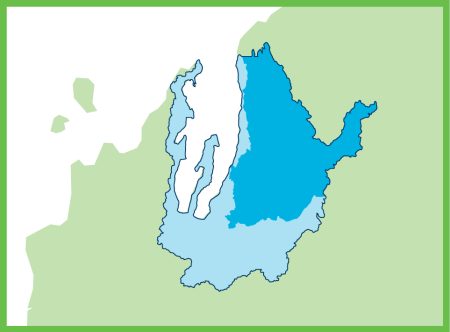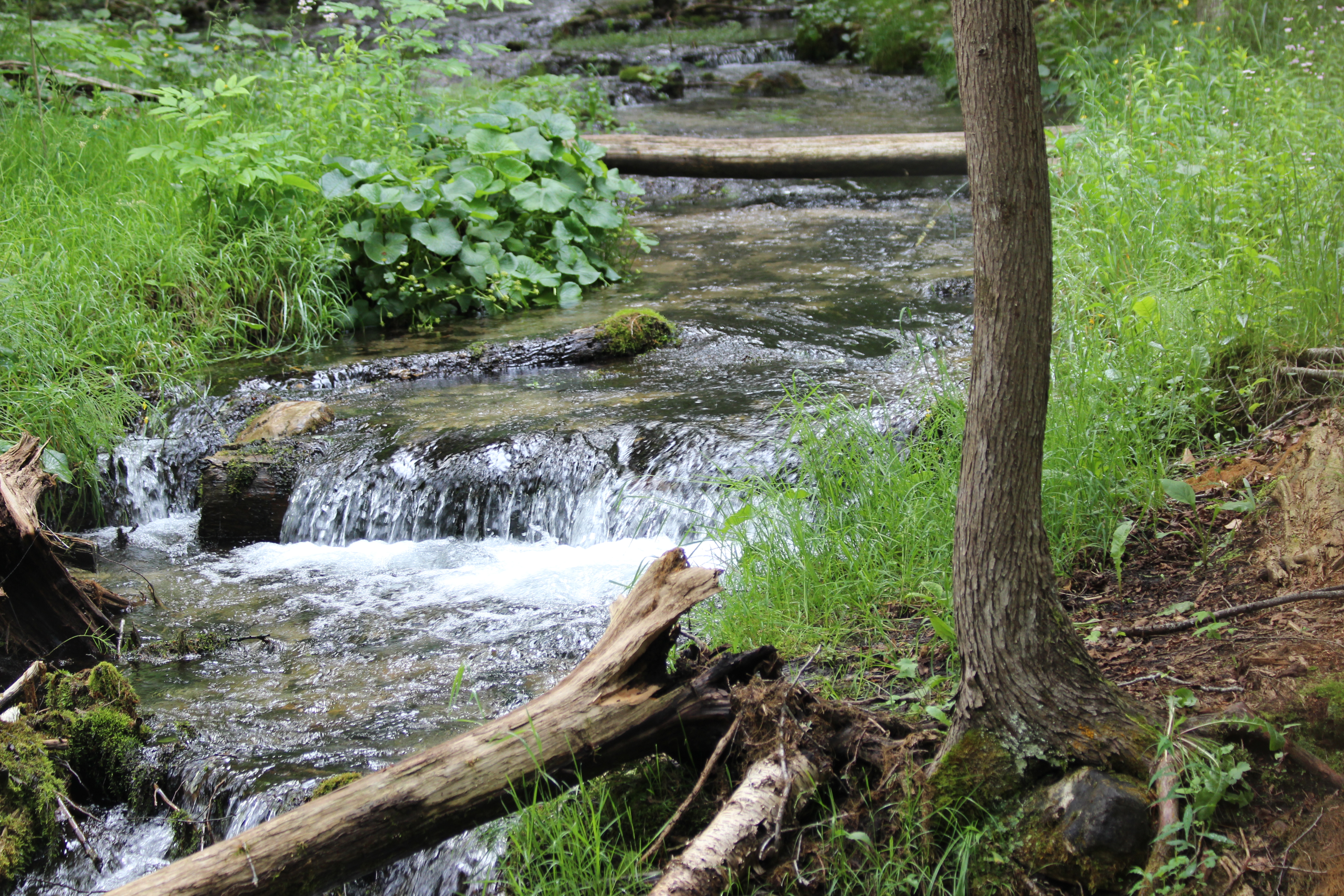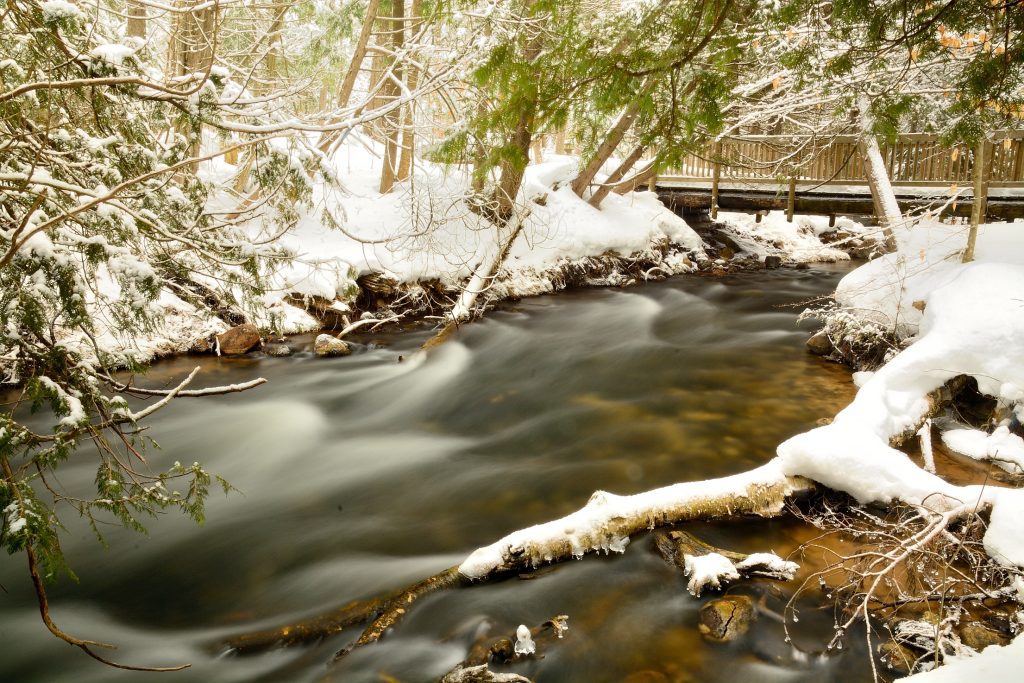waterfront
resource guide
for property owners in the Elk River Chain of Lakes watershed.
Chain of Lakes.
Grand Traverse Bay Watershed.
The Chain of Lakes and its surrounding watershed encompasses 500 square miles of land and contributes more than 60% of the surface freshwater flowing into Grand Traverse Bay in Lake Michigan.
Our Watershed
The foundation of the landscape was laid down millions of years ago when warm, shallow seas covered North America. Layers of mud covered ancient coral reefs on top of the shale and limestone bedrock in the Great Lakes basin.
More than 10,000 years ago, mile-high glaciers gauged the bedrock and left deposits of rock and soil up to 1,000 feet thick. We find fossilized coral called Petoskey stones on the shores of northern Michigan waters today.
Deeply scoured valleys and deep depressions created massive stranded blocks of ice that eventually filled with water and became known as the Elk River Chain of Lakes watershed.
Stretching 75 miles in length, the Chain of Lakes and its surrounding watershed encompasses 500 square miles of land. Our watershed contributes more than 60% of the surface freshwater flowing into Grand Traverse Bay in Lake Michigan.
At the centerpiece of the watershed are 14 interconnected lakes and rivers, more than 240 streams, 40 kettle lakes, and thousands of acres of wetlands. From the headwaters in the Hitchcock Swamp, through the marshy waters of Beals Lake downstream to the wave-swept, rocky shores of Elk Lake, the water in the Elk River Chain of Lakes watershed is generally high quality.

Grand Traverse Bay Watershed
Elk River Chain of Lakes Watershed
500
Square Mile Area
313
Miles of Rivers and Streams
14
Lakes
Chain of Lakes
Upper Chain
Hitchcock Swamp
Beals Lake
Scott’s Lake
Six Mile Lake
St. Clair Lake
Ellsworth Lake
Wilson Lake
Benway Lake
Hanley Lake
Intermediate Lake
Intermediate River
Lower Chain
Lake Bellaire
Grass River
Clam Lake
Clam River
Torch Lake
Torch River
Skegemog Lake
Elk Lake
Elk River
Dams
The construction of dams in the watershed have altered the depth and flow of rivers and lakes. The dam in Elk Rapids has been important in preventing invasive fish species, such as sea lamprey, from entering the Chain of Lakes.

1800's
1856 – First dam and sawmill constructed on Elk River in Elk Rapids
1861 – Dam in Elk Rapids raised and rebuilt
1881 – Dam in Elk Rapids rebuilt, covering stumps & burying the rapids
1900's
1900 – Hydro-dam built on the Intermediate River in Bellaire
1925 – Hydro-dam built on Elk River in Elk Rapids
1940 – Hydro-dam rebuilt in Elk Rapids
1943 – Dam built on Cedar River in Bellaire, creating Craven Pond
1973 – Elk & Skegemog lakes court-ordered lake levels: summer (April 15-October 31) 590.8 feet, winter (November 1-April 14) 590.2 feet
1974 – Dam on Intermediate River rebuilt in Bellaire
1986 – Intermediate Lake court-ordered lake levels: summer (May 15-October 31) 607.15 feet, winter (November 1-May 14) 606.54 feet
1990 – Court reaffirms the 1996 court-ordered lake levels for Intermediate Lake
2000's
2003 – Dam rebuilt on Cedar River in Bellaire to provide fish passage
2015 – Elk Rapids hydro-dam received 30-year relicense from the Federal Energy Regulatory Commission
Our People
For thousands of years, native Anishinaabek people used the Elk River Chain of Lakes watershed for summer hunting camps. They caught and smoked fish, gathered berries and other wild foods, and hunted game such as rabbits and black bear. Many of their place’s names, such as Kewadin, are used today.
After the Chicago Fire in 1871, the area was cleared of timber, opening the land to farmers. Early settlements were established at Eastport, Spencer Creek (later Alden), Kewadin, and Elk Rapids. Antrim County was established in 1840, and the county seat was moved from Elk Rapids to Bellaire in 1879.
Early resorters came by train from Chicago and Detroit to fish in the Chain of Lakes. Cabins, resorts, and hotels were built on the shores of the lakes. Passenger boats transported visitors from Elk Rapids to these destinations throughout the Chain of Lakes. It was not until the 1960s that people began retiring to the area and constructing year-round homes.
In 1920, the population of Antrim County was 11,543. In 2020, the population was 23, 841. Now during the summer season, the population increases to more than 75,000. More than 200,000 tourists visit the watershed during the summer.
Our Natural Resources

Antrim County has an 88-year history of acquiring forest lands, natural lands, and park lands for the public. They have conserved more than 5,000 acres to help protect the clear, clean waters of the Elk River Chain of Lakes watershed.
1935
First Public Forest – using the Michigan Municipal Forest Act passed in 1931, Antrim County acquired 160 acres for the Hawk Lake Forest near Mancelona.
1938
First County Public Park – Antrim County acquired land that became Barnes Park for $1,000. Later acquisitions would expand the park for camping and recreation on Lake Michigan.
1969
First Natural Lands – Antrim County began acquiring land for the Grass River Natural Area with assistance from the Three Lakes Association Grass River Committee. Grass River Natural Area, Inc., began managing the natural area for Antrim County in 1979. The natural area now includes more than 1,492 acres.
1975
First County Forester – Antrim County hired a professional forester to manage county Forest Lands sustainably so future generations can enjoy the natural beauty and diversity of our watershed.
Watershed Management
Antrim County has also supported federal grants to protect the high quality waters of the Elk River Chain of Lakes watershed. Millions of federal and state dollars have been devoted to managing the Chain of Lakes.
1980's
1989 – First Elk River Chain of Lakes Watershed Master Plan (Northwestern Michigan Council of Governments)
Antrim County worked with NMCOG and received a grant from the U.S. Environmental Protection Agency to develop a master plan for the watershed.
1989 – First Elk River Chain of Lakes Watershed Advisory Committee
The Advisory Committee was established to help develop the Master Plan. The committee consisted of local citizens, representatives from local governments, and state agencies. The Advisory Committee has continued to guide conservation activities in the watershed for the last 35 years. Over the years, the committee has been called the ERCOL Steering Committee, the ERCOL Conservation Network, and the ERCOL Watershed Plan Implementation Team (WPIT).
1990's
1995 – First Elk River Chain of Lakes Watershed Management Plan (Conservation Resource Alliance)
1993 – First Elk River Chain of Lakes Watershed Feasibility Study (Michigan Department of Natural Resources)
1995 – First Elk River Chain of Lakes Watershed Clean Lakes
Phase 2 – Implementation Proposal (Antrim Soil & Water District)
2000's
2001 – Second Elk River Chain of Lakes Watershed Management Plan (Conservation Resource Alliance)
2003 – First Elk River Chain of Lakes Watershed Reference Manual (Michigan Department of Natural Resources)
2018 – State and federally approved Elk River Chain of Lakes Watershed Management Plan (Tip of the Mitt Watershed Council and The Watershed Center Grand Traverse Bay)


Watershed Stewardship
Local and regional nonprofit organizations have raised millions more from private individuals and grants to support education, outreach, demonstration, restoration, conservation, monitoring, and research projects throughout the Elk River Chain of Lakes watershed.
1936 Thayer Lake Owners Association
1944 Antrim Conservation District
1950 Elk-Skegemog Lakes Association
1955 Lake Bellaire Improvement Association
1966 Three Lakes Association (Torch Lake, Clam Lake & Lake Bellaire)
1970 Elk River Drainage Basin Council
1979 Grass River Natural Area
1979 Tip of the Mitt Watershed Council
1988 Six Mile Lake Association
1994 Torch Lake Property Owners Association (now Torch Lake Protection Alliance)
1998 Intermediate Lake Association (for profit changed to nonprofit organization in 2006)
1991 Grand Traverse Regional Land Conservancy
1994 The Watershed Center Grand Traverse Bay
2001 Antrim County United for Ecology
2007 Friends of Clam Lake
2013 Torch Conservation Center
2014 Paddle Antrim
2020 Torch, Elk, Skegemog Alliance



 Donate
Donate